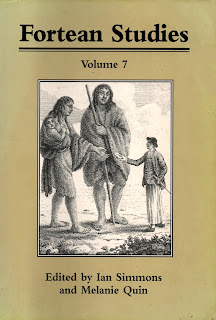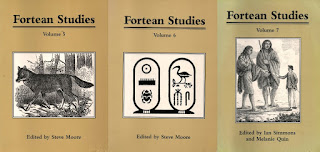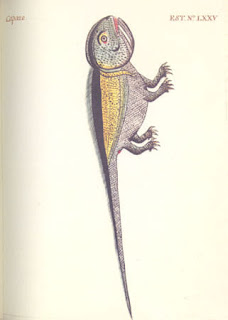Is
this a bilby I see before me – in Peru?? (public domain)
In my previous ShukerNature blog article
(click here
to access it), I documented two unexpected creatures depicted in a magnificent
mural-format pictorial encyclopaedia entitled Quadro de Historia Natural, Civil y Geografica del Reyno del Peru
('Painting of the Natural, Civil and Geographical History of the Kingdom of
Peru'), or QHNCGRP for convenience hereafter
in this present article. Consisting of numerous miniature oil paintings and
accompanying text on a wood panel, it measures a very impressive 128
x 45.25 inches (325 x 115 cm).
Completed in Madrid, Spain, in 1799 and
now on display at the Museo Nacional de Ciencias Naturales in Madrid (Spain's
national museum of natural history), which has produced an exquisite, lavishly-illustrated website devoted specifically
to it (click here),
QHNCGRP was authored by Basque-born
but (for three decades) Peru-based scholar José Ignacio Lequanda, who
commissioned French artist Louis Thiébaut to produce the 194 paintings
illustrating it. As noted above, most of these are miniatures, with tiny but
voluminous text by Lequanda accompanying all of the 160 miniatures depicting
fauna and flora of Peru or its South American environs.
The vast majority of these miniatures
depict readily-recognisable Neotropical species, including a large spotted
rodent named the paca, a South American zorro or 'fox' (actually a species of Dusicyon canid), an otter, tapir,
manatee, various monkeys, trumpeter bird, cock of the rock, spoonbill,
hummingbird, Humboldt's penguin, skunk, caiman, giant anteater, fulgorid lantern-fly,
llama, vicuna, armadillos, coati, and opossum, to mention but a few.
View
of QHNCGRP in its entirety – click to
enlarge for viewing purposes (© Museo Nacional de Ciencias Naturales –
reproduced here on a strictly non-commercial Fair Use basis for
educational/review purposes only)
Also present, however, are certain
decidedly mystifying zoological portraits, such as that of a dramatically
out-of-place Madagascan black-and-white ruffed lemur and one of a putative
living ground sloth, both of which I documented in my previous QHNCGRP article.
Since writing that, I have been paying
further close attention to this marvelous pictorial menagerie, and I've spotted
several additional examples included within it that are nothing if not curious
or controversial, for various differing but equally interesting reasons. So
here they are – make of them what you will!
Take, for instance, the very distinctive
creature portrayed in the QHNCGRP
miniature that opens this present ShukerNature article. Whereas I am not aware
of any South American mammal matching its morphology (Lequanda claimed it to be a vizcacha, and others have suggested the latter rodent's relative the chinchilla, but these bear little – in the case of the chinchilla – or no – in the case of the vizcacha – resemblance to it, I am aware that it does bear
a remarkable similarity to a certain species of exclusively Australian
marsupial. Namely, the lesser bilby (aka lesser rabbit-eared bandicoot) Macrotis leucura.
Mystery
big-eared, long-snouted, plume-tailed QHNCGRP
mammal (above) and a painting of a lesser bilby from English zoologist Oldfield
Thomas's Catalogue of the Monotremes and
Marsupials in the British Museum (Natural History) (below) (public domain)
Certainly, its long snout, lengthy plumed
tail, and very sizeable ears all correspond very closely to those of the latter
species. True, its forelimbs are much the same size as its hind ones, whereas
those of the lesser bilby are shorter, and its fur is white rather than brown
like the bilby's. However, the limb discrepancy may simply be an error on
Thiébaut's part, especially if his subject's preserved skin had become
distorted via shrinkage. Moreover, preserved skins frequently blanch if exposed
too long to light (the taxiderm thylacine that was on public display in
London's Natural History Museum when I visited in 2014, for example, was so
faded, predominantly cream in colour all over, that its diagnostic stripes had
vanished).
Deriving its English name from its very
large, slender, rabbit-like ears, and characterized by its tail's long white
hairy plume, the lesser bilby was once native to the deserts of central
Australia, but has not been conclusively sighted since the 1950s, so is now
deemed extinct. Back when QHNCGRP was
created, however, it was still in existence, with preserved specimens in
museums.
As apparently happened with the ruffed
lemur, is it possible, therefore, that Lequanda and/or Thiébaut saw a museum specimen
of the lesser bilby at Madrid's celebrated Royal Natural History Cabinet
(founded in 1771, opened to the public in 1776, and whose contents were very
familiar to Lequanda), or even elsewhere, and mistakenly assumed that it was a
Neotropical species? Or might Thiébaut have based his miniature upon some
pre-existing artwork by another artist? There is a notable QHNCGRP–linked precedent for this latter possibility.
Thiébaut's
zebra-striped QHNCGRP mystery monkey
(top left), Compañon's earlier artwork upon which Thiébaut's was based (top right),
and a South American tree porcupine (below) (public domain / public domain / (©
Eric Kilby/Wikipedia – CC BY-SA 2.0 licence)
One of the several monkeys depicted as
miniatures in QHNCGRP by Thiébaut is
the extraordinary-looking striped example shown above. Its bold zebra-like body
and limb markings instantly set it apart from any currently-known monkey
species, as does the mid-dorsal row of spines running down its back. These are
also alluded to by Lequanda, in his accompanying text. He referred to this fascinating
fasciated creature as a casacuillo, and also mentioned that it lived upon fruit.
Rather than basing his illustration of this
casacuillo upon first-hand observations of a living or preserved animal,
however, Thiébaut used as his inspiration a pre-existing 18th-Century
illustration. Namely, a water-colour prepared some years earlier with 1,410
others for inclusion in the Codex Martínez
Compañon, a sumptuous nine-volume manuscript made by Baltasar Jaime Martínez
Compañon, Bishop of Trujillo, Peru. This water-colour is also shown here, for
comparison purposes alongside Thiébaut's oil painting.
Moreover, according to writer Carmen
Martínez, writing in an online article from June 2021 devoted to QHNCGRP (click here
to access it), this creature is not a monkey at all, but is instead a South
American tree porcupine or coendou, of which there are many species, all
sporting a prehensile tail. However, to me it looks no more like a tree porcupine
than it does a monkey! Coendous are not striped and their fine spines are
present profusely over their entire body, not merely along their back. So I am
unconvinced by this identification.
A
striped carrot on legs!! Another of Triébaut's bemusing mystery beasts included
by him in QHNCGRP (public domain)
And speaking of zebra-patterned mystery
beasts depicted in QHNCGRP, what are
we to make of the example shown above? It looks for all the world like a striped
carrot on legs! It seems to be furry, eared, and whiskered, and is included in the left-hand block of 30
mammal miniatures (according to Lequanda, moreover, it is, once again, a coendou!), so we must assume that it is indeed mammalian – or should
we?
After all, also included in this same
block of miniatures is the following bizarre beast, popularly if improbably(?)
deemed to be a portrait of an iguana according to various sources consulted by
me
Yet this latter beast is itself a major
mystery. For it seems to possess a stiff pointed tail wholly unlike the highly
flexible tail of an iguana, as well as long curved fangs emerging from its
jaws, and what looks like a pair of wings pressed tightly against its flanks! Apparently, like the striped monkey/coendou illustration, Thiébaut based his miniature upon one from the Codex Martínez
Compañon that was labelled as an iguana. Really??
A
supposed iguana depiction by Thiébaut in QHNCGRP
(above) and the original version in the Codex (below) (public domain)
Most improbable of all, however, must
surely be the next example presented here. What on earth (or in the air!) is
this extraordinary squirrel-like entity that sports not only two pairs of limbs
and a bushy tail but also a pair of wings – and which are clearly functional,
given that Thiébaut has portrayed it flying above a somewhat larger, rodent-like
mammal in the same miniature?
Might it be the inaccurate result of
Thiébaut painting not from direct observation of some physical specimen, but
instead merely from a verbal description of a flying squirrel? True, the name of
these rodents is something of a misnomer, seeing that they become airborne not
with the assistance of wings but instead via a pair of gliding membranes (patagia),
linking their wrist and ankle on each side of their body. But if a verbal
description of such a creature does not make this distinction clear to an
artist seeking to depict it, the result might well be an illustration of a
squirrel-like creature boasting a pair of bona fide wings.
Yet even if that were true, there is still
a fundamental problem in applying it as an explanation for this aerial anomaly as
portrayed here, because although flying squirrels are widely distributed in
North America, they do not occur anywhere in South America. So why would
Thiébaut have depicted one in QHNCGRP?
Yet another instance of someone wrongly assuming that a given creature is
Neotropical when it definitely is not? Having said that, Thiébaut's illustration is yet again a copy of one from the Codex Martínez
Compañon, but in that version the flying entity looks far more like a bird than a mammal, so why did Thiébaut convert it into one in his copied version? Conversely, at least according to Lequanda's accompanying description of it in QHNCGRP, it is indeed a rodent with wings, and is referred to by him as a mutmut. All very strange!
Thiébaut's
bewildering winged squirrel in QHNCGRP
(above) and the original bird-like version in the Codex (below) (public domain)
My concern with the ostensibly
unidentifiable mystery creatures from QHNCGRP
documented by me here is that, as already noted, most of the animals depicted
in it by Thiébaut are readily recognisable. So as those were all accurately
represented by him, why should the mystery beasts here not be too, unless he was indulging in some sly humour at Lequanda's expense, perhaps? Yet if they are accurate representations, why can we
not identify them?
Might at least some of them not have
arisen through misapprehensions regarding the origins of specimens utilized as
subjects, or even as a result of poor verbal descriptions of such, but instead
be bona fide native Neotropical species that have become extinct before ever
becoming known to European scientists, so their morphological appearance is
wholly unfamiliar to us?
The last anomalous animal to be
considered here may provide key evidence that some of Thiébaut's miniatures
depict significant creatures that were still unknown to science at the time
when he depicted them.
The
supposed lowland tapir depicted in QHNCGRP
(public domain).
Just a few hours after I posted my
previous QHNCGRP-themed ShukerNature
article, on 22 December 2022, I received a very interesting, thought-provoking
comment from a reader with the Google username Andrew, and which I duly posted
beneath my article. It concerns the QHNCGRP
miniature of what is officially assumed to be a specimen of the lowland (Brazilian)
tapir Tapirus terrestris, the largest
species of native mammal known to be alive today in South America, and
occurring widely here, including in Peru. Here is Andrew's comment:
Thiébaut's depiction of the
tapir looks like it could have been based on descriptions of the
then-undiscovered mountain tapir, rather than the lowland species. It has no
crest, its coat is almost black with a slight chestnut tint, and it seems to have
white lips.
Smaller and darker in colour than the
lowland tapir, the mountain tapir T.
pinchaque is a very distinctive species that is indeed uncrested and
white-lipped. It is also noticeably woolly, and looking at the tapir miniature in
close-up its body surface does appear to be hairy. Moreover, of particular
historical note is that this species, which is indeed native to Peru (occurring
in its far north's montane cloud forests), was not formally described by
science until 1829 – 30 years after the creation of QHNCGRP.
A lowland
tapir (top) and a mountain tapir (bottom) (© Dr Karl Shuker / (© Richard
Sifry/Wikipedia – CC BY 2.0 licence)
In short, if the tapir miniature in QHNCGRP actually depicts a mountain
tapir rather than a lowland tapir, this means that Thiébaut had portrayed a
major mammalian species three decades before its official discovery. This in turn begs the question: what specimen
was utilized by Thiébaut as the subject for his illustration?
Whichever it was, and wherever it was,
its taxonomic significance as representing a dramatic new species had clearly
not been recognized or appreciated by scientists of the day.
As I have revealed many times in my trio
of books on new and rediscovered animals, this is a sad situation that has occurred
countless times down through the centuries, with obscure museum specimens having
been long overlooked before belatedly receiving serious attention, only for
them then to be revealed as extraordinary new species whose existence had never
previously even been suspected, let alone confirmed. So the potential example
documented above has plenty of precedents, that's for certain!
My
three books on new and rediscovered animals (© Dr Karl
Shuker/HarperCollins/Stratus Publishing/Coachwhip Publications)
























































